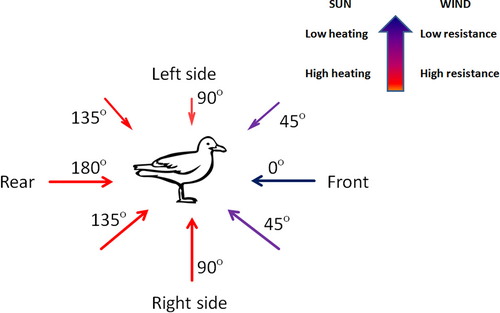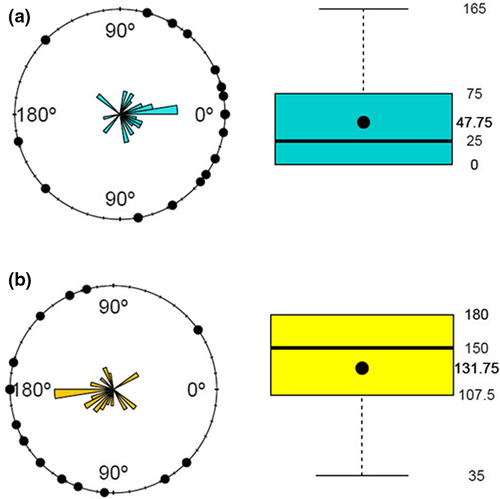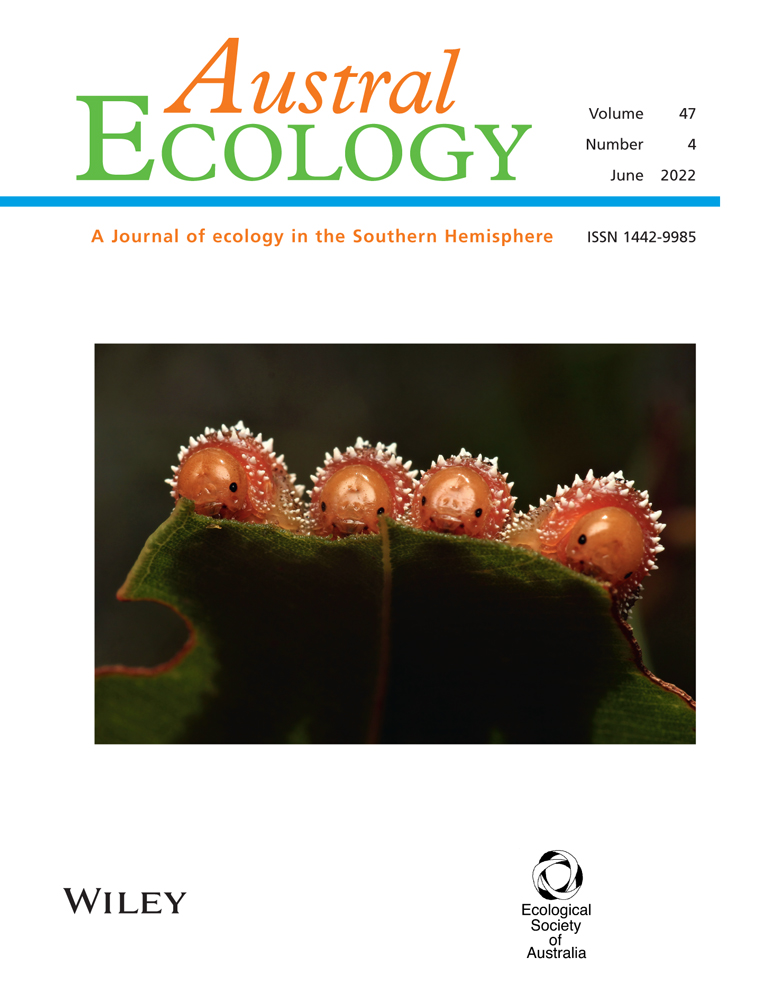Shorebirds adjust resting orientation in response to solar radiation and wind speed
All applicable international, national and institutional guidelines were followed for the development of this observational study.
Abstract
Animals may signal behavioural responses to climate stressors. To date, there has been no study investigating the altered behaviour of birds due to the synergetic effects of wind, solar radiation and ambient temperature in natural environments. We analysed the body orientation of three close-related Charadriiformes species with different body masses in response to wind speed, wind direction, sun position and ambient temperature on beaches in south-eastern Brazil. We expected these birds to adjust their postures according to the intensity of climate stressors and their different body masses. We found that regardless of body mass, resting birds faced the wind according to its speed and reduced their surface area exposed to airflow. They also exhibited a perpendicular orientation to the sun in lower ambient temperatures, which correlated with higher wind speeds. The behavioural adjustments of resting birds to concomitant climate stressors may prevent body destabilization and promote thermoregulation and energy savings.
INTRODUCTION
The behavioural adjustments of animals to climatic stressors are crucial given the actual impact of climate change on biodiversity (Kearney et al. 2009, Beever et al. 2017, McFarland et al. 2019). Endothermic and ectothermic species may adjust their sensory apparatuses, physiology and body orientation according to the variability and magnitude of water and wind fluxes, ambient temperature and solar radiation to save energy and avoid injuries (Stelzner & Hausfater 1986, Wolf & Walsberg 1996, Chapman et al. 2011, Mason 2017).
Birds live worldwide and have evolved several physiological, morphological and behavioural adaptations to thermoregulate. Feathers, a counter-current circulatory system acting in their bare areas (e.g. feet, legs and beak), choice of postures and behaviours (e.g. standing on one leg or sitting down, placing the bill back and within the plumage, wing-dropping and panting), and cutaneous evaporation may help regulate their body temperature (Hohtola et al. 1980, Wolf & Walsberg 2000, Scott et al. 2008, Tattersal & Cadena 2010, Gerson et al. 2014, Tattersal et al. 2017, Ryeland et al. 2019). They may also adjust body orientation to a wide variety of ambient temperatures. For example, herring gulls (Larus argentatus) may face away or perpendicular to the sun to increase their exposed surface area when the ambient temperature is lower (Lustick et al. 1978). In warmer temperatures, red knots (Calidris canutus) may experience up to 17% more heat loss standing with their flanks (a more exposed body area) facing into the wind (Wiersma & Piersma 1994). However, in addition to adjusting postures according to ambient temperature and solar radiation, resting birds deal with air resistance and biomechanical constraints, which may require extra energy to maintain body balance (Robinson et al. 1976, Walsberg 1986, Wiersma & Piersma 1994). They also may face the wind and take advantage of body aerodynamics, attempting to diminish air resistance (Lustick et al. 1978).
Ectothermic (e.g. butterflies and damselflies) and endothermic animals (e.g. baboons and wildebeests) adjust body orientation according to wind flux, sun position and ambient temperature in their natural environments (Berry et al. 1984, Polcyn & Chappel 1986, Stelzner & Hausfater 1986, Mason 2017). However, no study has investigated the body orientation of birds under the diversity of environmental stimuli in situ. Hence, the influence of their morphology, body mass and size could also be relevant to estimate body air resistance to wind flux and heat exchanges with the environment (Chapman et al. 2011, Barton et al. 2014, Whitfield et al. 2015, Mason 2017). Smaller species are probably more dependent on their postures concerning the wind speed and sun directions. For wind variability, they may adopt smaller body angles to the opposite wind. For the latter, they may adopt larger body angles to the sun than larger species as wind speed increases and ambient temperature decreases. These behaviours are affected by the lower body mass that dictates thermoregulation in smaller species (Weathers 1981, Wolf & Walsberg 1996, Meiri & Dayan 2003).
We analysed the body orientation of three species of Charadriiformes with different body masses in regards to wind speed and direction, sun position and ambient temperature on beaches in south-eastern Brazil. We hypothesized that resting birds should minimize energy costs by adjusting their body orientation to the synergistic effects of the above variables. This behavioural flexibility helps them save energy during climate variation (Kearney et al. 2009, Beever et al. 2017, McFarland et al. 2019). We hypothesized that birds should adopt smaller body angles to the wind and greater body angles to the sun under lower ambient temperatures, usually associated with windy occasions, to reduce their static resistance and increase body temperature (Fig. 1). We studied three related Charadriiformes species with similar body morphology but different body masses. We expected body mass to influence their orientation according to the wind speed and temperature on sunny days.

METHODS
Study area and species
The study was conducted on 9 km of beaches in Itanhaém city (24°13′37.28” S and 46°51′36.92” W), São Paulo State, south-eastern Brazil. Beaches were flat and 87 ± 9 m wide during low tide. They had compact and moist sand on where the tide reached and soft, dry sand (approximately 10 m) out of reach of the tide (Cestari et al. 2020). Climate is rainy tropical with a regional average annual temperature of 21°C ± 3°C, rainfall above 2000 mm/year and relative humidity over 70% (Köppen 1948, Tarifa 2004). Historical data collected over 40 years showed a range in absolute temperatures from 2.4°C to 40.8 °C for the region (Tarifa 2004). Resting birds were initially detected using binoculars from distances between 50 m – 80 m on the beaches during the mornings (7:30 am – 11:00 am) and afternoons (4:30 pm – 6:00 pm) on six random sunny and windy days from November 2019 to January 2020. During these months, minimum and maximum temperature recordings were 12.1°C and 39.9°C (Tarifa 2004). We considered resting birds as stationary with no apparent behaviours other than preening. We recorded the orientation of the birds using their head direction in reference to the wind direction (bird-wind angle) and the sun position (bird-sun angle). We observed solitary birds to avoid any influence of flocks on thermoregulation and energy efficiency (Wiersma & Piersma 1994). We classified 00 as when the bird's head was facing directly towards the wind or sun and 1800 when the bird's head was directly away (Fig. 1). When we approached the resting birds, we noted their orientation before they took flight. Birds moved when the observer got within 0.5–3 m. Immediately after taking flight, we collected their bird-wind and bird-sun angles using a compass. The windspeed and ambient temperature were recorded 10 cm above the ground using a portable anemometer with a thermometer (Vonder TAV 030) facing the wind. We observed birds on different beach stretches to minimize the likelihood of studying the same individuals. Data were collected for the three most abundant Charadriiformes species with light, intermediate and heavy body masses: semipalmated plover (Charadrius semipalmatus) at 47.4 g, southern lapwing (Vanellus chilensis) at 327 g and kelp gull (Larus dominicanus) at 1050 g. Species body masses were obtained from Dunning Jr. (2008).
Statistical analyses
We used generalized linear models (GLM) with Gaussian distribution to evaluate: (1) the effect of wind speed on ambient temperature, (2) the effect of wind speed and body mass categories (lighter, intermediate and heavier) on the bird-wind angle, (3) the effect of ambient temperature and body mass of bird species on the bird-sun angle and (4) the relationship between bird-wind and bird-sun angles. Log transformation of data was needed for analysis of the fourth variable. All analyses were performed in R Statistical software v 4.1.0 (R Core team 2021). We used alpha level ≤0.05.
RESULTS
We sampled 20 semipalmated plovers, 13 southern lapwings and 7 kelp gulls. Wind speed and ambient temperature ranged from 0.2 m s−1 to 9.0 m s−1 and 26.1 °C to 32.5 °C. The average bird-wind angle was 44.7° ± 48.8° (mean ± SD), and the average bird-sun angle was 131.7° ± 50.6 ° (mean ± SD) (Fig. 2).

The generalized linear model showed that: (1) as wind speed increased, temperature decreased (F = 23.5, df = 38, R2 = 0.38, P <0.001; Best-fit equation: Temperature = 30.37–0.28*Wind speed; Appendix S1, Fig. a), (2) birds opted for smaller angles when exposed to stronger winds (Table 1; Best-fit equation: Bird-wing angle = 76.8–8.55*Wind speed; F = 18.48, df = 38, R2 = 0.31, P <0.001; Appendix S1, Fig. b) and (3) birds opted for larger sun angles when exposed to low temperatures (Table 1; Best-fit equation: Bird-sun angle = 521.13–13.29*Temperature; F = 7.07, df = 38, R2 = 0.16, P = 0.01; Appendix S1, Fig. c). Therefore, individual birds found optimal angle positions to the wind and sun while resting (Fittest equation: Log bird-sun angle = 5.08–0.11 Log bird-wind angle; F = 7.19, df = 38, R2 = 0.16, P = 0.01; Appendix S1, Fig. d). The bird-sun angle increased with a decrease of bird-wind angle. Bird body mass (light, intermediate or heavy) did not influence bird-wind and bird-sun angles (Table 1).
| Dev | df | Res. Dev | F | P | |
|---|---|---|---|---|---|
| Bird-wind angle | |||||
| Wind speed (Ws) | 30392.1 | 38 | 62 505 | 19.19 | <0.001 |
| Mass (M) | 4753.2 | 36 | 57 752 | 1.50 | 0.24 |
| Ws × M | 3907.5 | 34 | 53 845 | 0.23 | 0.30 |
| Bird-sun angle | |||||
| Temperature (T) | 15 659 | 38 | 84 111 | 7.62 | 0.009 |
| Mass (M) | 11 657 | 36 | 72 461 | 2.83 | 0.07 |
| T × M | 2594 | 34 | 69 867 | 0.63 | 0.54 |
DISCUSSION
Our results showed that three species of birds with different body masses faced the wind with smaller bird-wind angles and reduced the surface area exposed to airflow according to increasing wind speed; they also exhibited a perpendicular orientation to the sun with larger bird-sun angles in low ambient temperatures. There was a negative correlation between bird-sun and bird-wind angles, showing a fine-tuning adjustment of body orientation according to wind speed, temperature and solar radiation. Most likely, these behavioural adjustments prevented body destabilization and promoted thermoregulation and energy conservation while resting.
The alterations in orientation of animals concerning wind direction (i.e. rheotaxis) and solar radiation are primarily expected in small-bodied species and ectotherms, which are more sensitive to changing conditions of their environment (Polcyn & Chappel 1986, Mason 2017). However, they are also found in endotherms (Berry et al. 1984, Stelzner & Hausfater 1986). Our results on birds, which can reach the highest endothermic temperatures (Lustick et al. 1978, Wiersma & Piersma 1994), corroborated their probable need to dissipate heat generated by higher metabolisms, as well as to control heat gained from the environment (O'Connor et al. 2016). At lower wind speeds and higher ambient temperatures (Appendix S1, Fig. a), birds adjusted their body position with smaller angles to the sun. Thus, they reduced the surface area exposed to the sun and avoided overheating. On the other hand, birds adjusted their body position to be more perpendicular to the sun during higher wind speeds and lower ambient temperatures (Appendix S1, Fig. c), which increased their chances of gaining heat from the environment (Fig. 1). Moreover, they probably saved energy facing the wind direction according to its increasing speed to prevent body destabilization (Appendix S1, Fig. b) (Lustick et al. 1978, Robinson et al. 1976).
Solar radiation and wind have significant impacts on the energy exchange of birds with the environment. For instance, a 936 W m−2 solar heat gained by a 25.5 g passerine can be equivalent to a four-fold reduction (from 2 m s−1 to 0.5 m s−1) in wind speed under laboratory conditions (Wolf & Walberg 2000). Probably, variation in solar radiation, wind speed and ambient temperature were triggering shorebirds to adjust body orientation when resting (Grubb Jr. 1975; Beever et al. 2017). Even the restricted range of the climatic variables found in our study (e.g. 0.2 m s−1 to 9.0 m s−1 windspeed and 26.1°C to 32.5°C) influenced an adjustment in body orientation in shorebirds. It showed the species' capacity to modulate behaviour regarding climate parameter variations from opened coastal habitats.
We cannot discard the effect of air humidity on the thermoregulation and behaviour of shorebirds (Grubb Jr. 1975; Gerson et al. 2014). Coastal areas are frequently exposed to high air humidity coming from the sea. It may inhibit heat loss in shorebirds by cutaneous evaporative cooling and influence their body position to the sun and wind. Shorebirds probably assume smaller angles to the sun and larger angles to wind on hot and moist days. However, this posture is probably dependent on the wind's presence and intensity. Higher wind speed should force birds to face the wind and not waste energy on body stabilization. An example of a cooling effect inhibition linked to body position occurs when mammals, such as wildebeests, do not find water in the African savannah. They usually assume a parallel body orientation to the incoming radiation to compensate for the excessive heat compared to random body orientations in wet and moist areas (Berry et al. 1984).
Although body mass is an important parameter in estimating air resistance and the heat exchange of organisms (Chapman et al. 2011, Barton et al. 2014, Whitfield et al. 2015, Mason 2017), our results showed that it did not influence the body orientation of the Charadriiformes species under the measured climate parameters. The influence of body mass on bird orientation may depend on other characteristics that we did not measure, such as plumage colouration and depth (i.e. depressed or erected) and total exposure time of birds to sun and wind. Smaller and darker species with depressed plumage warm faster than larger species. Therefore, the former is less resilient to strong winds. They spend less time in prolonged stressful environmental conditions to balance their energy than larger species (Lustick et al. 1978, Weathers 1981, Wiersma & Piersma 1994, Wolf & Walsberg 1996, Wolf & Walsberg 2000, Meiri & Dayan 2003, Whitfield et al. 2015).
Animals may signal behavioural responses to climate stressors (Berger-Tal et al. 2011). Most likely, the adoption of an optimal orientation under simultaneous climatic triggers delays other behaviours (e.g. panting and gular flutter) that would increase evaporative water loss or cause the birds to expend more energy by increasing activities or moving to other places (e.g. shadings and shelters) to reach normothermia (Bakken & Lee 1992, Pattinson et al. 2019). Behaviour flexibility is valuable to species survivorship because the climate is increasingly unbalanced due to human activities, which stresses biodiversity (Beever et al. 2017). We believe that the adjustment of body orientation under various abiotic conditions may be widespread to many bird species. Future studies are needed to investigate the morphological and behavioural parameters of body orientation in natural microclimate conditions. Comparative studies on the seasonal variations of climatic variables and their possible effects on the body orientation of birds are also needed.
ACKNOWLEDGEMENTS
We thank two anonymous reviewers for their valuable suggestions to improve this manuscript. We also thank the Graduation Program in Ecology, Conservation and Biodiversity from Universidade Federal de Uberlândia and CAPES for financial support (Process Number 88882.314750/2019-01) to CC.
AUTHOR CONTRIBUTIONS
Cesar Cestari: Conceptualization (lead); data curation (lead); formal analysis (lead); investigation (lead); methodology (lead); project administration (lead); supervision (lead); validation (lead); writing – original draft (lead); writing – review and editing (lead). Celine de Melo: Conceptualization (supporting); data curation (supporting); formal analysis (supporting); investigation (supporting); methodology (supporting); project administration (supporting); supervision (supporting); validation (supporting); writing – original draft (supporting); writing – review and editing (supporting).
CONFLICT OF INTEREST
The authors declare that they have no conflict of interest.
Open Research
DATA AVAILABILITY STATEMENT
The data that support the findings of this study will be available in Dryad Repository.




